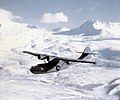| Carrier Aircraft Service Unit | |
|---|---|
 Carrier Aircraft Service Unit Logo | |
| Branch | U.S. Navy |
| Type | World War II Aircraft Service Unit |
| Role | Military engineering |
| Nickname | CASU |
| Colors | |
| Engagements | Guadalcanal, Bougainville, Los Negros, Guam, Peleliu, Tarawa, Kwajalein, Saipan, Tinian, Iwo Jima, Philippines, Okinawa |



Carrier Aircraft Service Units (CASU) were United States Navy units formed during World War II for the Pacific War to support naval aircraft operations. From 1942 to 1946, 69 Carrier Aircraft Service Units were formed to repair and maintain aircraft. The first unit was deployed to Naval Station Pearl Harbor. The CASU-11, was deployed on January 22, 1943, at Naval Air Station San Diego. During the war the Navy lacked enough aircraft carriers to complete all the operational requirements. [1]

















